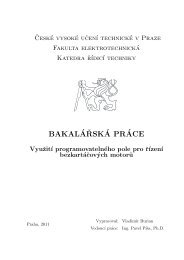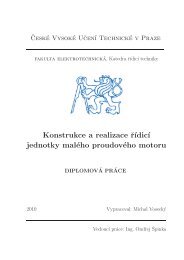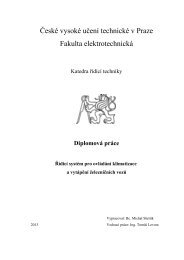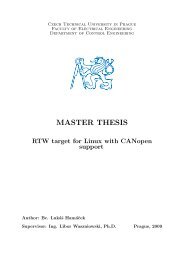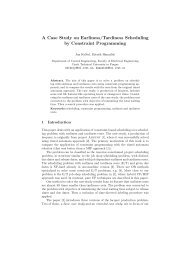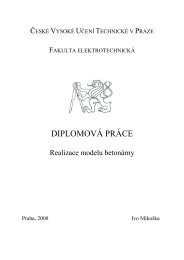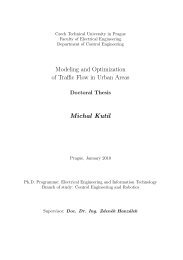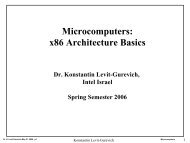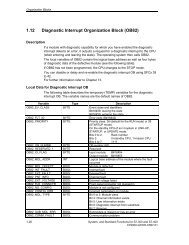Bachelor Thesis - Czech Technical University in Prague
Bachelor Thesis - Czech Technical University in Prague
Bachelor Thesis - Czech Technical University in Prague
Create successful ePaper yourself
Turn your PDF publications into a flip-book with our unique Google optimized e-Paper software.
<strong>Czech</strong> <strong>Technical</strong> <strong>University</strong> <strong>in</strong><strong>Prague</strong>Faculty of Electrical Eng<strong>in</strong>eer<strong>in</strong>gDepartment of Control Eng<strong>in</strong>eer<strong>in</strong>g<strong>Bachelor</strong> <strong>Thesis</strong>Modell<strong>in</strong>g of dielectrophoresis for feedbackcontrolAuthor: Ivan NikolaevTutor: Ing. Jiří Zemánek <strong>Prague</strong>, 2012
AcknowledgmentI would like to thank Jiří Zemánek for be<strong>in</strong>g a helpful and knowledgable tutorwithout whose guidance I would not be able to complete this work. I wouldalso like to thank my mother who has always given me her full support.ii
DeclarationI declare that I have created this bachelor thesis by myself and have onlyused the sources provided <strong>in</strong> the list of references.<strong>Prague</strong> ................. .........................Signatureiii
AbstractThis work deals with simulation of behaviour of microscopic particles subjectedto dielectrophoretic forces. The goal is to create a simulation whichwill help to design and test a feedback control algorithm.In this work a hybrid approach to simulation is taken which consists oftwo parts: preprocess<strong>in</strong>g and simulation. Preprocess<strong>in</strong>g is done <strong>in</strong> ComsolMultiphysics. The data from preprocess<strong>in</strong>g is then used for the simulationwhich is done <strong>in</strong> Matlab. Preprocess<strong>in</strong>g helps to speed up the simulation byavoid<strong>in</strong>g unnecessary repetition of the same calculations.The simulation is then compared with numerical and analytical solutionsas well as laborarotary experiments.AbstraktV této práci budeme simulovat chování mikroskopických částic pod vlivemdielektroforetické síly. Našim cílem je vytvořit simulaci, kterou bude možnépoužít při návrhu zpětnovazebního řízení. Při tvorbě simulace aplikujemehybridní přístup, který se skládá ze dvou částí: přípravný výpočet (předvýpočet)a samotná simulace. Přípravný výpočet (předvýpočet) provedeme vprogramu Comsol Mutyphisycs, který nám umožní simulaci urychlit omezenímopakování stejných výpočtů. Získaná data pak použijeme při simulaci, kterouprovedeme v Matlabu. Simulaci následně porovnáme s numerickými a analytickýmiřešeními a také s laboratorními experimenty.iv
Contents1 Introduction 12 Dielectrophoresis 22.1 Dielectrophoretic force . . . . . . . . . . . . . . . . . . . . . . 22.2 Clausius-Mossotti factor . . . . . . . . . . . . . . . . . . . . . 42.3 Actuators . . . . . . . . . . . . . . . . . . . . . . . . . . . . . 52.4 Other forces . . . . . . . . . . . . . . . . . . . . . . . . . . . . 62.4.1 Viscous drag . . . . . . . . . . . . . . . . . . . . . . . . 62.4.2 Buoyancy . . . . . . . . . . . . . . . . . . . . . . . . . 62.4.3 Brownian motion . . . . . . . . . . . . . . . . . . . . . 73 Simulation approaches 83.1 Analytical . . . . . . . . . . . . . . . . . . . . . . . . . . . . . 83.2 Numerical . . . . . . . . . . . . . . . . . . . . . . . . . . . . . 93.3 Hybrid . . . . . . . . . . . . . . . . . . . . . . . . . . . . . . . 103.4 Dynamic trajectory model<strong>in</strong>g . . . . . . . . . . . . . . . . . . 123.5 Surface charge density . . . . . . . . . . . . . . . . . . . . . . 133.5.1 F<strong>in</strong>ite element analysis . . . . . . . . . . . . . . . . . . 133.5.2 The method of moments . . . . . . . . . . . . . . . . . 134 Simulations 164.1 Analytical simulations . . . . . . . . . . . . . . . . . . . . . . 174.2 Numerical simulations . . . . . . . . . . . . . . . . . . . . . . 184.2.1 2D . . . . . . . . . . . . . . . . . . . . . . . . . . . . . 184.2.2 3D . . . . . . . . . . . . . . . . . . . . . . . . . . . . . 194.3 Hybrid simulations . . . . . . . . . . . . . . . . . . . . . . . . 214.3.1 Preprocess<strong>in</strong>g - Comsol export . . . . . . . . . . . . . . 214.3.2 Preprocess<strong>in</strong>g - Live-L<strong>in</strong>k, mph<strong>in</strong>terp . . . . . . . . . . 224.3.3 Preprocess<strong>in</strong>g - Live-L<strong>in</strong>k, <strong>in</strong>tegration <strong>in</strong> Comsol . . . . 22v
4.3.4 Preprocess<strong>in</strong>g - splitt<strong>in</strong>g electrodes <strong>in</strong>to subareas <strong>in</strong>Comsol . . . . . . . . . . . . . . . . . . . . . . . . . . . 224.3.5 Preprocess<strong>in</strong>g - Method of Moments . . . . . . . . . . . 224.3.6 Calculat<strong>in</strong>g the force . . . . . . . . . . . . . . . . . . . 235 Results comparison 255.1 Numerical vs. analytical . . . . . . . . . . . . . . . . . . . . . 255.2 Hybrid vs. analytical . . . . . . . . . . . . . . . . . . . . . . . 255.3 Hybrid vs. experimental . . . . . . . . . . . . . . . . . . . . . 286 Conclusion 30References 30vi
1 IntroductionThe goal of this work is to create a simulation of the behaviour of particlessubjected to dielectrophoretic force. The simulation can then be used to helpanalyse the behaviour of particles under different electrode configurations,frequencies and voltage patterns. The simulation can also be used to createan MPC controller, which requires a model for its operation.In the first part the theory beh<strong>in</strong>d dielectrophoresis is presented. Inthe second part different simulation approaches are expla<strong>in</strong>ed. In the thirdpart the author’s simulations are presented. In the fourth the results of thesimulations are compared with each other and with experimental results.1
2 DielectrophoresisDielectrophoresis is a phenomenon that describes a force experienced by polarizableparticles when subjected to non-uniform electric field. The particlesare generally <strong>in</strong> the 1 to 1000 µm range. For bigger particles the effects ofgravity usually prevail and for smaller particles the behaviour of <strong>in</strong>dividualparticles becomes upredictable due to effects of Brownian motion. The fieldcan be either DC or AC. In AC fields the forces depend on the frequency anddifferent frequencies result <strong>in</strong> different phenomena like positive and negativedielectrophoresis or travell<strong>in</strong>g wave dielectrophoresis. In this section the theorybeh<strong>in</strong>d dielectrophoresis is briefly expla<strong>in</strong>ed for the benefit of the readerand for easy referenc<strong>in</strong>g from later sections. The theory is taken from [1] and[2]2.1 Dielectrophoretic forceDielectrophoresis occurs when a polarizable particle is exposed to an electricfield. The electric field causes a dipole to form with<strong>in</strong> the material. Ifthe field is uniform, the forces on the dipole charges are equal and act <strong>in</strong>opposite directions, so that the net force is zero. In a non-uniform field howeverthe force on one charge will be different from the force on the othercharge result<strong>in</strong>g <strong>in</strong> a net force on the particle. The force is referred to as thedielectroforetic force and the phenomena is known as dielectrophoresis.If we consider a dipole with charges separated by vector d at location r,then the net force on the particle can be described by the Equation (2.1)F = Q + E(r + d) − Q − E(r) (2.1)S<strong>in</strong>ce d is small relative to the size of the field non-uniformity, we canmake an approximationE(r + d) = E(r) + d · ∇E(r) (2.2)2
and rewrite the force as:F = Qd · ∇E (2.3)The dipole moment is def<strong>in</strong>ed as:m = Qd (2.4)Therefore we can rewrite the force equation as:F = (m · ∇)E (2.5)For spherical dielectric particles the dipole moment is described by thefollow<strong>in</strong>g equation:m(ω) = 4πR 3 ɛ 0 K(ω)E (2.6)where R is the radius of the sphere, ɛ 0 is the permittivity of vacuum andK(ω) is the Clausius-Mossotti factor, dependent on the frequency.If we consider E as a phasor Ẽ, then m(ω) also becomes a phasor andthe time-averaged force can be given byF = 1 2 Re[( ˜m(ω) · ∇)Ẽ∗ ] (2.7)asBy substitut<strong>in</strong>g the dipole moment phasor we can rewrite the expression8πR 3 ɛ 0 K(ω)(Ẽ · ∇)Ẽ∗ = 4πR 3 ɛ 0 K(ω)(Ẽ · Ẽ∗ ) − 4πR 3 ɛ 0 K(ω)∇ × (Ẽ × Ẽ∗ ). This uses two identities:(2.8)∇(A · B) = (B · ∇)A + (A · ∇)B + B × (∇ × A) + A × (∇ × B) (2.9)3
and∇ × (A × B) = (B · ∇)A − (A · ∇)B + (∇ · B)A−(∇ · A)B (2.10)and the fact that the electric field is irrotational, i.e. ∇ × Ẽ = 0 and Gauss’slaw with zero free charge density, i.e. ∇ · Ẽ = 0. The time-averaged forcethen becomes:F DEP = πR 3 ɛ 0 ɛ m Re[K(ω)]∇(|Re[Ẽ]|2 + |Im[Ẽ]|2 ) (2.11)F twDEP = −2πR 3 ɛ 0 ɛ m Im[K(ω)](∇ × Re[Ẽ] × Im[Ẽ]) (2.12)Equation (2.11) gives time-averaged force for conventional dielectrophoresis.Equation (2.12) gives time-averaged force for travell<strong>in</strong>g wave dielectrophoresis.2.2 Clausius-Mossotti factorThe dielectrophoretic force is frequency-dependent. The frequency dependanceis given by the Clausius-Mossotti factor which is def<strong>in</strong>ed <strong>in</strong> the follow<strong>in</strong>gequation:K(ω) = ɛ∗ p − ɛ ∗ mɛ ∗ p + 2ɛ ∗ m(2.13)where ɛ ∗ m and ɛ ∗ p are the complex permittivity of the medium and particleand ɛ ∗ = ɛ − j(σ/ω), where ɛ is the permittivity, σ is the conductivity and ωis the angular frequency. The real part of the Clausius-Mossotti factor determ<strong>in</strong>esthe dielecrophoretic force the imag<strong>in</strong>ary part determ<strong>in</strong>es the travell<strong>in</strong>gwave dielctrophoretic force. Clausius-Mossotti factor is shown <strong>in</strong> Figure 2.1for ɛ m = 78, σ m = 0.001, ɛ p = 2.55 and σ p = 0.01(water and polystyrene).It can be seen that for frequencies below approximately 1.76 MHz the realpart is positive and for the frequencies above that the real part is negative.4
The frequency where Re[K(ω)] = 0 is called the cross-over frequency. Atthat frequency dielectrophoretic force does not act on the particles and thetravell<strong>in</strong>g wave dielctrophoresis becomes most prom<strong>in</strong>ent. For frequenciesbelow the cross-over frequency the force experienced by the particles is towardsthe electrodes. It is called positive dielectrophoresis. For frequenciesabove the cross-over frequency the force is <strong>in</strong> the opposite direction, awayfrom the electrode, which is referred to as negative dielectrophoresis.0.80.6RealImag0.40.20−0.2−0.4−0.6−0.810 4 10 5 10 6 10 7Frequency [Hz]Figure 2.1: Clausius-Mossotti factor for polystyrene <strong>in</strong> deionised water.2.3 ActuatorsThere are many possible electrode actuator comb<strong>in</strong>ations used for creat<strong>in</strong>gelectric fields. In this work we will be consider<strong>in</strong>g a simple parallel electrode5
array while tak<strong>in</strong>g <strong>in</strong>to consideration potential future extension for morecomplex configurations.2.4 Other forcesOther forces which are not dielectrophoretic but are nevertheless important<strong>in</strong> simulat<strong>in</strong>g the motion of a particle subjected to dielectrophoresis are:viscous drag, buoyancy and brownian motion.2.4.1 Viscous dragViscous drag is a friction force that retards the motion of a particle mov<strong>in</strong>gthrough a fluid. The viscous drag force is very significant for colloidal particles,so that they reach their term<strong>in</strong>al velocity <strong>in</strong> a few nanoseconds. Fora spherical particle of radius r the term<strong>in</strong>al velocity can be determ<strong>in</strong>ed byStoke’s law and is given by the expression:F = −6πηrV (2.14)where η is the viscosity of the medium.2.4.2 BuoyancyThe particles also experience the force of gravity. The force is usually verysmall, but can be observed over time. The force is given by the equation:F sediment = ν(ρ m − ρ p )g (2.15)where ν is the volume of the particle, ρ m and ρ p are the densities of themedium and the particle. If the particle is denser than the medium it wills<strong>in</strong>k(sediment) over time if it is less dense than the medium it will float.6
2.4.3 Brownian motionAll the particles are subject to Brownian motion. The effect is more pronouncedfor smaller particles. For bigger particles random collision tend tocancel each other out more evenly. The mean displacement due to Brownianmotion for spherical particles is given by|△d| =√k B T t3πηr(2.16)where k B is the Boltzmann constant, T is the temparture <strong>in</strong> Kelv<strong>in</strong>, r isthe radius of the particle and η is the viscosity of the medium.Brownian motion is important because although the time-averaged forceis zero the mean displacement is non-zero which means it has to be overcomeby the dielectrophoretic force <strong>in</strong> order to successfully control the particle.7
3 Simulation approachesThere are different simulation approaches for dielectrophoresis. In this partwe are go<strong>in</strong>g to look at some of them and discuss their advantages and disadvantages.We will be look<strong>in</strong>g at analytical, numerical and hybrid approaches.3.1 AnalyticalThe analytical approach to simulation attempts to f<strong>in</strong>d the dielectrophoreticforces by deriv<strong>in</strong>g the equations that give the dielectrophoretic force for specificelectrode configurations.Analytical simulations give fast and preciseresults. However, analytical solutions are hard to f<strong>in</strong>d even for the simpleelectrode arrays. They become nearly impossible for more complex electrodearrays which makes them impractical for real-life applications.In this paper we implement a simulation from [3] for two-phase electrodearray with approximate boundary condition, as well as two-phase electrodearray with exact boundary condition. Approximate boundary condition assumesthat the the potential at y=0 between the electrodes changes l<strong>in</strong>early.The exact boundary condition assumes that the normal derivative of the potentialis zero at the boundary between the electrodes. The simulations aredone by simply solv<strong>in</strong>g an equation at specified coord<strong>in</strong>ates and electroderatio parameters. d 1 be<strong>in</strong>g the width of the electrode, d 2 the gap betweenthe electrodes, V the applied voltage and x and y the coord<strong>in</strong>ates. G(ω) isthe product of Clausius-Mossotti factor and the volume of the particle.The equation for the approximate boundary condition two-phase electrodeis:F DEP = 16V 2πd(d 2 ) 2 Re[G(ω)] · Re []izh(¯z; d 14d )h′ (z; d 1) 4d−zh(¯z; d 14d )h′ (z; d 1) 4d(3.1)where d = (d 1 + d 2 )/2, z = exp( π(ixy−π(ix+y)), ¯z = exp( ), h(z; q) =2d2d1 1+2zcos(qπ)+z2ln( ), h ′ (z; q) =(1−z2 )cos(qπ).4 1−2zcos(qπ)+z 2 1−2z 2 cos(2qπ)+z 48
The equation for the exact boundary condition two-phase electrode is:F DEP =[π 3 V 22K 2 (cos(πq/2))d Re[G(ω)] · Re 3izk(¯z; q)k ′ (z; q)−zk(¯z; q)k ′ (z; q)](3.2)where d = (d 1 + d 2 )/2, q = d 1 /(2d), z = exp( π(ix−y) ), ¯z = exp(− π(ix+y) ),ddzk(z; q) = () 1/2 , k ′ 1−z(z; q) = 2and K is the completeelliptic function of the first1−2zcos(qπ)+z 2 2k(z;q)(1−2zcos(qπ)+z 2 ) 2k<strong>in</strong>d.3.2 NumericalNumerical simulations are based on f<strong>in</strong>ite element method software. Thesimulation for parallel electrode array can be done <strong>in</strong> 2d s<strong>in</strong>ce the lengthof the electrodes is significantly greater than their width. They can alsoassumed to be <strong>in</strong>f<strong>in</strong>itely th<strong>in</strong>, s<strong>in</strong>ce their width is significantly greater thantheir thickness. The result<strong>in</strong>g solution will be <strong>in</strong>correct close to the electrodeedges, but that is not so important s<strong>in</strong>ce the DEP force approximation is<strong>in</strong>valid <strong>in</strong> that region anyway due to rapid variations of the electric field[2].It is important to def<strong>in</strong>e proper boundary conditions for the FEM software,otherwise the results will be highly distorted. There are two boundaryconditions that can be used: the Neumann boundary condition for the electricpotential <strong>in</strong> the electrolyte (∂ ˜φ/∂n = 0, where n is the normal to theboundary and ˜φ is the electric potential phasor). The other condition is theDirichlet condition (˜φ = 0). The lower boundary must be assigned the Neumannboundary condition, due to current conservation argument. The upperboundary condition can be either Neumann or Dirichlet. It should be placedhigh above the area of <strong>in</strong>terest to make sure it does not <strong>in</strong>fluence the results.The side conditions can be determ<strong>in</strong>ed through a symmetry argumentfor symmetrical electrode arrangements and specific potentials. Consider anelectrode array shown <strong>in</strong> Figure 3.1. The electrodes have 90 ° phase shiftbetween them. We have chosen to simulate the area between 0 ° and 90 °9
electrodes. The boundaries cut the electrodes <strong>in</strong> half, we can use the Dirichletboundary condition for the boundary above the electrodes whose elecricpotential is 0, because they are located midway between two electrodeswith equal electric potential of opposite signs. Boundary go<strong>in</strong>g through theelectrodes with non-zero electric potential should be assigned the Neumanncondition as it is the symmetry axis between two 0 electric potentials.Numerical simulations theory is taken from [2]3.3 HybridHybrid simulation uses the power of numerical simulation for preprocess<strong>in</strong>gdata for different array configurations and then us<strong>in</strong>g the preprocessed datato quickly f<strong>in</strong>d the force when it’s required. In this work we will use theapproach from [4].This approach uses bidimensional electrode mesh<strong>in</strong>g pr<strong>in</strong>ciple for preprocess<strong>in</strong>g.The electrodes are all meshed along directions x and y. Figure 3.2shows an example of mesh for a 4 electrode parallel array. A voltage is appliedto one electrode while the rest are kept at zero. The surface charge onthe electrodes is then calculated and <strong>in</strong>tegrated on each mesh piece. Eachmesh piece is then represented by an elementary charge located at its center.The process is done for n electrodes for an (n+1)-electrode matrix. Oneelectrode is always kept at zero and is used as the reference one. The electricfield is the sum of contributions of elementary charges Q r,s at po<strong>in</strong>t P (r, s).The electric field is then:E(x, y, z) =12πɛ 0 ɛ m∑e x e∑ yr=1 s=1Q r,s ·−−−−−−−−−−−→P (r, s)M(x, y, z)|| −−−−−−−−−−−→P (r, s)M(x, y, z)|| 3 ds (3.3)Q r,s can be calculated us<strong>in</strong>g the superposition pr<strong>in</strong>ciple:Q r,s =n∑C r,s,m · U m (3.4)m=110
Figure 3.1: 2d boundary conditions. ˜φ represents the electric potential phasor.φ R = Re[ ˜φ] and φ I = Im[ ˜φ]. Redrawn from [3].11
U = [U 1 = ϑ 1 − ϑ 0 , ..., U n = ϑ n − ϑ 0 ] (3.5)The preprocessed data consists of the capacitance matrix C r,s,m of size(number of mesh elements <strong>in</strong> x direction, number of mesh elements <strong>in</strong> ydirection, number of electrodes − 1). Once E is known, the force can becalculated us<strong>in</strong>g Equations (2.11) and (2.12).Figure 3.2: Hybrid electrode mesh<strong>in</strong>g. Parallel electrode array.3.4 Dynamic trajectory model<strong>in</strong>gIn order to simulate the trajectory of a particle subjected to dielectrophoreticforce a dynamic type of simulation is required. Approach from [4] is expla<strong>in</strong>edbelow.Us<strong>in</strong>g the Newton’s second law, the motion of the particle is def<strong>in</strong>ed by12
the follow<strong>in</strong>g equation:F DEP + F sediment + F drag = ma (3.6)Where F DEP is the dielectrophoretic force described by Equations (2.11)and (2.12). F sediment is the buyoancy force def<strong>in</strong>ed <strong>in</strong> Equation (2.15), F dragis the drag force def<strong>in</strong>ed <strong>in</strong> Equation (2.14), m is the mass of the particle anda is the acceleration of the particle. Because the m constant is so small, thema term can be neglected. The equation can then be rewritten as:V = F DEP + F sediment6πηr(3.7)S<strong>in</strong>ce the term<strong>in</strong>al velocity is reached <strong>in</strong> such a short time, the particlecan be considered to be always mov<strong>in</strong>g at its term<strong>in</strong>al velocity, which meansthat Equation (3.7) expresses the velocity of the particle given the forces onit.3.5 Surface charge densityFor the hybrid simulation it is important to be able to calculate the surfacecharge density on the electrodes. We shall exam<strong>in</strong>e two approaches.3.5.1 F<strong>in</strong>ite element analysisIt is possible to use FEM software like Comsol multiphysics and then extractthe surface charge density data from it.3.5.2 The method of momentsAnother way to calculate the surface charge density is by us<strong>in</strong>g the methodof moments. The method of moments divides the surface <strong>in</strong>to a series ofs<strong>in</strong>gular charges whose contributions to the electric field are determ<strong>in</strong>ed bythe Coulomb’s law. Given known electrical potential and distance between13
the charges, it is possible to determ<strong>in</strong>e the value of each charge and henceapproximate the surface charge density.If we approximate the system of electrodes as n electrode subareas eachone with known potential V then we can describe the potential on eachelectrode <strong>in</strong> terms of the potential on itself and on all the other charges:V 1 = p 11 q 1 + p 12 q 2 + ... + p 1n q nV 2 = p 21 q 1 + p 22 q 2 + ... + p 2n q nV 3 = p 31 q 1 + p 32 q 2 + ... + p 3n q n (3.8).V n = p n1 q 1 + p n2 q 2 + ... + p nn q np ij is the potential on subarea i from a unit charge on potential j <strong>in</strong> theabsence of any other charges. V i is the potential on subarea i, q i is the chargeon subarea i.p ij =ˆ1 σj |dA j |4πɛ 0 ɛ m |r ij |(3.9)Where ɛ m is the relative permittivity of the medium, σ j is the surfacecharge density on subarea j. S<strong>in</strong>ce j holds unit charge σ j = 1 A j. r ij is thedistance between the charges. The above <strong>in</strong>tegration is given by, providedthe rectangle j does not cross the x or y axes4πɛ 0 ɛ m A j p ij = |I(x 2 , y 2 ) − I(x 2 , y 1 ) − I(x 1 , y 2 ) + I(x 1 , y 1 )| (3.10)whereI = x · s<strong>in</strong>h −1 ( y|x| ) + y · s<strong>in</strong>h−1 ( x|y| ) (3.11)14
If the rectangle crosses the x or y axes, it should be subdivided <strong>in</strong>to two(orfour) rectangles that do not cross the axes. Expression 3.8 can be written <strong>in</strong>vector form:Or:⎛⎜⎝⎞ ⎛V 1V 2.⎟⎠ = ⎜⎝V n⎞ ⎛p 11 p 12 . p 1np 21 p 22 . p 2n. . . .⎟ ⎜⎠ ⎝p n1 p n2 . p nn⎞q 1q 2.⎟⎠q n(3.12)The charge Q can therefore be found as:V = PQ (3.13)Q = P −1 V (3.14)The method of moments theory is taken from [1].15
4 SimulationsIn this section the author’s simulations are presented. Dur<strong>in</strong>g the mak<strong>in</strong>gof these simulations the author encountered many problems and dead ends.Some of these will be presented here <strong>in</strong> order to show the amount of workdone as well as warn anyone who reads this of the complications they mayencounter shall they attempt to create a similar simulation.Simulations show ∇E 2 for the dielectrophoretic force and ∇ × Re[Ẽ] ×Im[Ẽ] for the travell<strong>in</strong>g wave dielectrophoretic force, neglect<strong>in</strong>g the constantsand the Clausisus-Mossotti factor. Simulations work with length ratios forthe electrodes, not their real lengths. Force can be calculated from the simulationdata by tak<strong>in</strong>g the particle size, Clausisus-Mossotti factor and electrodelengths <strong>in</strong>to account.Simulations are done for a parallel electrode configuration, as shown <strong>in</strong>Figure 4.1.Figure 4.1: Parallel electrode array.16
4.1 Analytical simulationsAnalytical simulations are probably the most straightforward ones <strong>in</strong> termsof implementation. Simulations give the force at specific coord<strong>in</strong>ates, giventhe electrode to gap ratio and the voltage. Figure 4.2 shows an example of ananalytic solution. Analytic solution with approximate boundary condition iscalculated us<strong>in</strong>g Equation (3.1). The simulation is calculated by functionanF2 (located <strong>in</strong> file anF2.m). Analytic solution with exact boundary conditionis calculated us<strong>in</strong>g Equation (3.2) and is calculated by function anF(found <strong>in</strong> file anF.m).1412Exact boundary conditionApproximate boundary condition1086Fx420−2−4−60 0.1 0.2 0.3 0.4 0.5 0.6 0.7 0.8 0.9 1xFigure 4.2: x-component of the force for analytic solution for d 1 /d 2 = 4electrode ratio, V = 1[V], y = 0.1. Units of length are dimeonsionless.17
4.2 Numerical simulationsSimulations were done <strong>in</strong> 2D and <strong>in</strong> 3D us<strong>in</strong>g Comsol Multyphysics software.In creat<strong>in</strong>g FEM simulations it is important to correctly def<strong>in</strong>e the doma<strong>in</strong>as well as boundary conditions.4.2.1 2DSimulations <strong>in</strong> 2D were based on [2]. The first simulation is of a parallelelectrode array with 180 degree phase shift between electrodes, mean<strong>in</strong>gthat when there is V potential on an electrode, there is −V potential on itsneighbours. The simulation is done for a s<strong>in</strong>gle electrode mak<strong>in</strong>g use of thesymmetry between the electrodes. The boundary conditions on the sides areDirichlet, s<strong>in</strong>ce the midpo<strong>in</strong>t between V and −V potentials is 0. Simulationcan be found <strong>in</strong> file DEPnum(1el).mph. Figure 4.3 shows results of the simulation.Arrows <strong>in</strong>dicate the direction of the force and the background colouris the logarithm of the force <strong>in</strong>tensity, with maximum and m<strong>in</strong>imum valuesadjusted for visibility purposes.Figure 4.3: Numerical simulation: 180 ° phase shift. Side view. Electrode is<strong>in</strong> the middle.18
Next numerical simulation is of a parallel electrode array with 90 degreephase shift between neighbour<strong>in</strong>g electrodes. In this set-up travell<strong>in</strong>g wavedielectrophoresis starts to show. Figures 4.4 and 4.5 show the results of thesimulation. The simulation is done as described <strong>in</strong> section 3.2. Both Dirichletand Neumann conditions are used. Simulation is <strong>in</strong> the file DEPnum.mph.Figure 4.4: 2D Numerical simulation: 90 ° phase shift dielectrophoresis. Sideview. Electrodes are on the sides, with a gap <strong>in</strong> the middle.4.2.2 3DNumerical simulations can also be used to create 3D models. Figure 4.6shows a simulation of a 4 electrode parallel array. It shows the logarithmusof the dielectrophoretic force <strong>in</strong>tensity <strong>in</strong> the zx-plane cutt<strong>in</strong>g through themiddle of the electrodes. Care has to be taken with the boundary conditions.One way to deal with them is by plac<strong>in</strong>g them far enough from the area of<strong>in</strong>terest so as to make their <strong>in</strong>fluence negligible. Simulation from Figure 4.6is located <strong>in</strong> the file DEPnum3d.mph.One disadvantage of 3D numerical simulations <strong>in</strong> Comsol is the speed. Ittakes a few m<strong>in</strong>utes to calculate a simple 4 electrode array model as shown <strong>in</strong>19
Figure 4.5: 2D Numerical simulation: 90 ° phase shift travell<strong>in</strong>g wave dielectrophoresis.Side view. Electrodes are on the sides, with a gap <strong>in</strong> themiddle.Figure 4.6: 3D Numerical simulation20
Figure 4.6. This makes it <strong>in</strong>feasible to use for simulations of more complicatedarrays, especially <strong>in</strong> real time.4.3 Hybrid simulationsHybrid simulations are the ma<strong>in</strong> subject of study <strong>in</strong> this report. They allowfor much faster calculations than the numerical simulations, but takeconsiderably more effort to implement. A lot of the problems arise at theComsol-Matlab <strong>in</strong>terface. In this section simulations will be presented alongsidewith unsuccessful attempts.Hybrid simulation consists of two parts: preprocess<strong>in</strong>g and force calculation.In the preprocess<strong>in</strong>g stage the capacitance matrix for a specific electrodearray is calculated which is then used to f<strong>in</strong>d the force given the potentialson <strong>in</strong>dividual electrodes. The capacitance matrix only needs to be calculatedonce for one electrode arrangement, it can then be stored and used whenrequired.In order to f<strong>in</strong>d the capacitance matrix, we have to be able to f<strong>in</strong>d thesurface charge density. The process consists of apply<strong>in</strong>g 1 V potential to oneelectrode and 0 V to all the other ones, calculat<strong>in</strong>g the surface charge denstiyacross all the electrodes and then approximat<strong>in</strong>g it as a matrix of s<strong>in</strong>gle po<strong>in</strong>tcharges. Approximation is done by divid<strong>in</strong>g the electrode plane <strong>in</strong>to a gridof smaller subareas. The surface charge density is then <strong>in</strong>tegrated over eachsubarea and the result assigned to a po<strong>in</strong>t charge which is <strong>in</strong> the middle ofeach subarea. For an n electrode array this process has to be repeated for(n − 1) electrodes.4.3.1 Preprocess<strong>in</strong>g - Comsol exportThe first attempt at preprocess<strong>in</strong>g was through the use of Comsol ’exportdata’ feature. The surface charge density was calculated directly <strong>in</strong> Comsol,then exported <strong>in</strong>to a file us<strong>in</strong>g the ’export data’ feautre. The data was then21
loaded <strong>in</strong> Matlab and <strong>in</strong>terpolated us<strong>in</strong>g the TriScatteredInterp function.This did not work, as the data got damaged somewhere along the way andthe output was mean<strong>in</strong>gless.4.3.2 Preprocess<strong>in</strong>g - Live-L<strong>in</strong>k, mph<strong>in</strong>terpSecond attempt was made by us<strong>in</strong>g Live-L<strong>in</strong>k Matlab <strong>in</strong>terface <strong>in</strong> Comsol.The data was requested us<strong>in</strong>g mph<strong>in</strong>terp function from Live-L<strong>in</strong>k <strong>in</strong>terface.It was then <strong>in</strong>terpolated us<strong>in</strong>g TriScatteredInterp function. It was then<strong>in</strong>tegrated over subareas and the capacitance matrix was found. The approachworked well, however there were some numerical errors which arosedur<strong>in</strong>g <strong>in</strong>terpolation and <strong>in</strong>tegration.4.3.3 Preprocess<strong>in</strong>g - Live-L<strong>in</strong>k, <strong>in</strong>tegration <strong>in</strong> ComsolThird attempt used Live-L<strong>in</strong>k, but requested Comsol for the <strong>in</strong>tegrated valuefor each subarea directly. This approach proved to give results with leastnumerical error, when compared aga<strong>in</strong>st the data <strong>in</strong> Comsol, however it tookvery long time to process.4.3.4 Preprocess<strong>in</strong>g - splitt<strong>in</strong>g electrodes <strong>in</strong>to subareas <strong>in</strong> ComsolFourth attempt <strong>in</strong>volved splitt<strong>in</strong>g electrodes <strong>in</strong>to subareas directly at thetime of the model creation <strong>in</strong> Comsol. This did not work, because Comsolreturned mean<strong>in</strong>gless data when queried for the charges on the electrodes.4.3.5 Preprocess<strong>in</strong>g - Method of MomentsAs an alternative, a preprocess<strong>in</strong>g technique was thought of which wouldleave out Comsol altogether and calculate the surface charge density directly<strong>in</strong> Matlab. This was done us<strong>in</strong>g the Method of Moments technique, as described<strong>in</strong> section 3.5.2. The P matrix was calculated us<strong>in</strong>g two different approachesfrom two different sources[5, 1] which both gave near-identical ma-22
trices. The result, however, varied from the Comsol result by a magnitude of2 or more for different electrode configurations, while agree<strong>in</strong>g on the generalshape of the charge distribution. An example of calculated charge density isshown <strong>in</strong> Figure 4.7. It shows a 4 parallell electrode array, with 1V potentialon the first electrode and 0V potential on the other electrodes. The methodof moments calculations are done <strong>in</strong> surface_charge.m. The electrode configurationcan be def<strong>in</strong>ed <strong>in</strong> the form of an image file(e.g. el4p2.png).0.50.40.30.20.10−0.1−0.210.80.60.40.200 0.1 0.2 0.3 0.4 0.5 0.6 0.7 0.8 0.9 1Figure 4.7: Surface Charge: MoM4.3.6 Calculat<strong>in</strong>g the forceEquation (2.11) describes the dielectrophoretic force. We can see that <strong>in</strong>order to calculate it we need to know the constants: permittivitty of themedium, size of the particle and the Clausius-Mossotti factor for the givenfrequency and we need to know the square of the electric field. Electric23
field can be calculated us<strong>in</strong>g Equation (3.3). Calculation of the force at anarbitrary po<strong>in</strong>t given the capacitance matrix and potentials on the electrodesis implemented <strong>in</strong> the function forceAt(<strong>in</strong> file forceAt.m). Calculation offorce distribution <strong>in</strong> space is done <strong>in</strong> file simulation.m.The force calculated <strong>in</strong> space over the electrodes is shown <strong>in</strong> Figure 4.8.The hybrid simulation takes considerably less time to calculate the force,once preprocess<strong>in</strong>g is f<strong>in</strong>ished.1.210180.86z−axis0.60.4420.200−2−0.2−0.2 0 0.2 0.4 0.6 0.8 1 1.2x−axisFigure 4.8: Hybrid 90 ° phase shift. View of the xz cut-plane. Arrows showthe direction of the force, colour the <strong>in</strong>tensity.24
5 Results comparisonIn this section the results of the simulations are compared with each other andthen discussed. First we compare numerical results with analytical. Thenhybrid vs. analytical. Then hybrid with the experimental resulsts.Unfortunately, due to a Comsol error it was impossible to export data foranalysis from a 3D numerical simulation.5.1 Numerical vs. analyticalIn this section we compare numerical results aga<strong>in</strong>st analytical. The numericalresults are exported from Comsol and then <strong>in</strong>terpolated <strong>in</strong> Matlab.The analytical results are calculated directly <strong>in</strong> Matlab. The results arethen plotted on a graph for visual comparison. Figures 5.1 and 5.2 showthe comparison of the x and y components of the dielectrophoretic force.It can be seen that the numerical solution and the analytical solution withexact boundary conditions are very similar while the analytical solution withapproximate boundary conditions differs for x > 0.7.5.2 Hybrid vs. analyticalHere we compare hybrid results with analytical. The hybrid simulation isused for an array of 10 electrodes, whose capacitance matrix was calculatedus<strong>in</strong>g method of moments. The results are compared for one electrode <strong>in</strong>the middle of the array. The simulation is done from the middle of thegap to the left of the electrode to the middle of the gap to the right of theelectrode. It is then recalculated to scale of the analytic solution and plottedon a graph. 0 on the graph represent the middle of the electrode <strong>in</strong> thecalculation. Figures 5.4 and 5.6 show comparison of the simulations of theforces <strong>in</strong> x and y direction(z direction for the hybrid, as it is <strong>in</strong> 3D).It can be seen that although the simulations differ <strong>in</strong> magnitude, thetrends <strong>in</strong> general shape are similar for both simulations. In case of the force25
141210Numerical solutionExact Boundary conditionApproximate boundary condition86Fx420−2−4−60 0.1 0.2 0.3 0.4 0.5 0.6 0.7 0.8 0.9 1xFigure 5.1: Comparison of numerical and analytical simulations. Force <strong>in</strong> xdirection for electrode ratio d 1 /d 2 = 4, y = 0.1.0−5−10Fy−15−20−25Numerical solutionExact boundary conditionsApproximate boundary condtions−300 0.1 0.2 0.3 0.4 0.5 0.6 0.7 0.8 0.9 1xFigure 5.2: Comparison of numerical and analytical simulations. Force <strong>in</strong> ydirection for electrode ratio d 1 /d 2 = 4, y = 0.126
1.5 x 105 4−1 −0.8 −0.6 −0.4 −0.2 0 0.2 0.4 0.6 0.8 11320.5100−0.5−1−2−1−3−1.5−1 −0.8 −0.6 −0.4 −0.2 0 0.2 0.4 0.6 0.8 1−4Figure 5.3: Force <strong>in</strong> x direction, hybrid simulation on the left, analytic onthe right.−0.0764−1.2−0.0766−1.4−0.0768−1.6−0.077−1.8−2−1 x 104 −1 −0.8 −0.6 −0.4 −0.2 0 0.2 0.4 0.6 0.8 1−0.0772−2.2−0.0774−2.4−1 −0.8 −0.6 −0.4 −0.2 0 0.2 0.4 0.6 0.8 1−0.0776Figure 5.4: Force <strong>in</strong> x direction, hybrid simulation on the left, analytic onthe right.27
<strong>in</strong> x direction the force is always directed towards the edges of the electrodes.For the force <strong>in</strong> y direction the force varies <strong>in</strong> a very similar way for bothsimulations, <strong>in</strong>creas<strong>in</strong>g over the edges of the electrodes and decreas<strong>in</strong>g overthe gaps.5.3 Hybrid vs. experimentalExperimental results were obta<strong>in</strong>ed for a parallel array of electrodes of width100 µm and width to gap ratio 1:1. The particles were polystyrene, 50 µm<strong>in</strong> diameter. The applied voltage was 7 V and the frequency was 400 kHz.The medium was deionised water. Only one electrode was activated at atime, while the rest rema<strong>in</strong>ed at zero potential. A photo of the experimentis shown <strong>in</strong> Figure 5.5.Figure 5.5: Photo of the experiment.For the given frequency and materials the dielectrophoresis is negative.This is supported by the experiment <strong>in</strong> which the particle always movesaway from the active electrode. Simulation predicts the same behaviour. InFigure 5.6 it can be seen that the force is <strong>in</strong> the direction away from theactive electrode. In negative dielectrophoresis particles go <strong>in</strong> the direction28
of decreas<strong>in</strong>g gradient. Particle stops after a certa<strong>in</strong> distance, because theabsolute force dim<strong>in</strong>ishes significantly with distance.Only some particles moved dur<strong>in</strong>g the experiment, while the majorityrema<strong>in</strong>ed stationary. This can be attributed to weak Van der Waals forcesthat keep the particles attached to the electrodes or to the gaps betweenthem.1.21010.850.6z−axis0.40.200−0.2−0.2 0 0.2 0.4 0.6 0.8 1 1.2x−axis−5Figure 5.6: Simulation, negative dielectrophoresis. 6th electrode is active,the rest are at zero potential.29
6 ConclusionIn this work we have looked at several ways of simulat<strong>in</strong>g dielectrophoreticforces. Analytical, numerical and hybrid simulations were implemented andcompared aga<strong>in</strong>st each other.Hybrid simulation exhibited similar trends <strong>in</strong> the shape of the force directionover the electrode array, however there were significant differences <strong>in</strong>magnitude when compared with numerical and analytical simulations. Thiscan be attributed to an error that the author was unable to identify. Theexperimental results agreed with the simulation predictions.The simulation was implemented <strong>in</strong> a way that will allow it to work withmore complex electrode arrays. It can potentially be used for design<strong>in</strong>g aregulator.In creat<strong>in</strong>g the simulation various books and scientific articles were consulted.The full list is provided below.30
References[1] Michael Pycraft Hughes. Nanoelectromechanics <strong>in</strong> Eng<strong>in</strong>eer<strong>in</strong>g and Biology.CRC Press, 2003.[2] H. Morgan N.G. Green, A. Ramos. Numerical solution of the dielectrophoreticand travell<strong>in</strong>g wave forces for <strong>in</strong>terdigitated electrode arraysus<strong>in</strong>g the f<strong>in</strong>ite element method. Journal of Electrostatics, 56:235–254,2002.[3] Igor Mezic Dong Eui Chang, Sophie Loire. Closed-form solutions <strong>in</strong>the electrical field analysis for dielectrophoretic and travell<strong>in</strong>g wave<strong>in</strong>ter-digitated electrode arrays. Journal of Physics D: Applied Physics,36:3073–3078, 2003.[4] Nicolas Chaillet Mohamed Kharboutly, Michael Gauthier. Model<strong>in</strong>g thetrajectory of a micro particle <strong>in</strong> a dielectrophoresis device. Journal ofApplied Physiscs, 106, 2009.[5] MF Iskander. Electromagnetics. Available at: http://t<strong>in</strong>yurl.com/momcharge.31
Appendix - list of filesanF.m calculates the dielectrophoretic force us<strong>in</strong>g the analytical solutionwith exact boundary conditionanF2.m calculates the dielectrophoretic force us<strong>in</strong>g the analytical solutionwith approximate boundary conditionCMf.m calculates the Clausius-Mossotti factorcmp.m plots graphs for different solutionsf<strong>in</strong>dC.m a function that <strong>in</strong>terpolates and <strong>in</strong>tegrates data from Comsol, used<strong>in</strong> preprocess.mforceAt.m function that returns the dielectrophoretic force at specific po<strong>in</strong>t<strong>in</strong> space given C matrix and the electrode potentialsgenfield.m function used <strong>in</strong> surface_charge.mim2el.m function that converts image to electrode dataImm.m function that is used <strong>in</strong> surface_charge.mPM.m function used <strong>in</strong> simulation.m and forceAt.mpreprocess.m calculates the C matrix us<strong>in</strong>g Comsol, works with Live-L<strong>in</strong>kComsolQf.m function used <strong>in</strong> simulation.m and forceAt.msimulation.m calculates the force for a grid <strong>in</strong> space. plots the resultssurface_charge.m calculates the C matrix us<strong>in</strong>g Method of MomentsDEPnum(1el).mph Comsol simulationDEPnum(4ratio).mph Comsol simulation32
DEPnum(tw).mph Comsol simulationDEPnum3d.mph Comsol simulationDEPnum4.mph Comsol simulationC(4el)100(c2).mat C matrix for 4 electrode parallel array, calculated <strong>in</strong>Comsol, us<strong>in</strong>g 2nd methodC(el10)125(m).mat C matrix for 10 electrode parallel array, calculated <strong>in</strong>Matlab, us<strong>in</strong>g MoM methodC(el15)200(m).mat C matrix for 15 electrode parallel array, calculated <strong>in</strong>Matlab, us<strong>in</strong>g MoM method*.png images of electrodes, for use with surface_charge.m33



